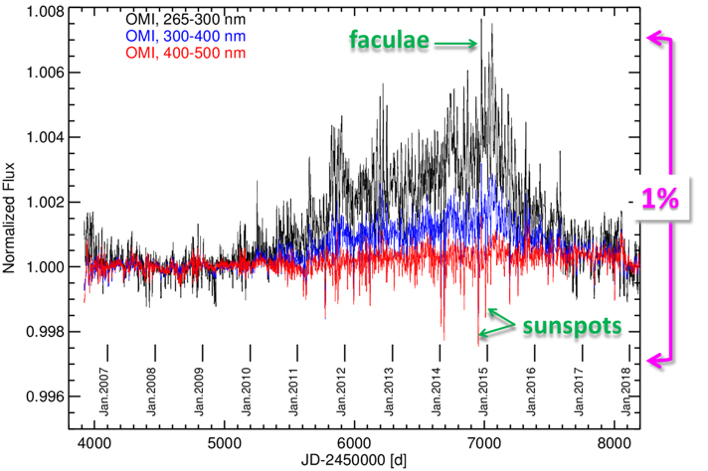
Technical description of figure:
The degradation-corrected and wavelength-binned ~daily OMI solar spectral irradiances follow the gradual changes of solar activity levels during the solar cycle 24. These gradual changes are frequently modulated by passage of large, relatively hot active regions (faculae) that mostly affect the shortwave radiation, producing sharp upward spikes. The hot facular regions are usually accompanied by groups of sunspots that are substantially cooler (darker) than the ambient solar surface. Such sunspot groups, once brought into the line of sight, cause rapid downward flux changes.
Scientific significance, societal relevance, and relationships to future missions:
Climate studies rely on detailed knowledge of the total energy balance, in particular, on the spectral and temporal changes of solar flux. These changes should be followed with ~weekly (preferably, ~daily) observations spanned over a typical solar cycle (~11 years), preferably multiple cycles. The Aura Ozone Monitoring Instrument is uniquely positioned to deliver the required long-term, stable, accurate ~daily solar data that span the entire solar cycle 24. The improved model of optical degradation of the instrument provides the solar spectral irradiances (SSI) that are broadly used for validation of the solar models, NRLSSI2 in particular. Comparison with the concurrent independent observations and model predictions show good-to-excellent (predominantly, to ∼ 0.1% in UV, and down to ∼ 0.01% in the visible) agreement between the various models and observations, if one to consider the relatively short-term (~months) events related to line-of-sight passage of active solar regions. The long-term (decadal, solar cycle) SSIs pose more challenges, with model-observation and observation-observation disagreements frequently exceeding ∼0.5% in the UV range (especially in the mid-UV domain populated by strong spectral transitions). In the visible, though, the long-term model-observation inter-comparisons show good agreement, down to ∼ 0.05%.
Data sources:
The degradation-corrected, wavelength-binned ~daily OMI solar observations are publicly available at: http://lasp.colorado.edu/lisird.
References: Marchenko, S.V., Woods, T.N., DeLand, M.T., Mauceri, S., Pilewski, P., Haberreiter, M., Aura/OMI Solar Spectral Irradiances: Comparisons with Independent Datasets and Model Predictions, Earth and Space Sci., in review, 2019.
9.2019